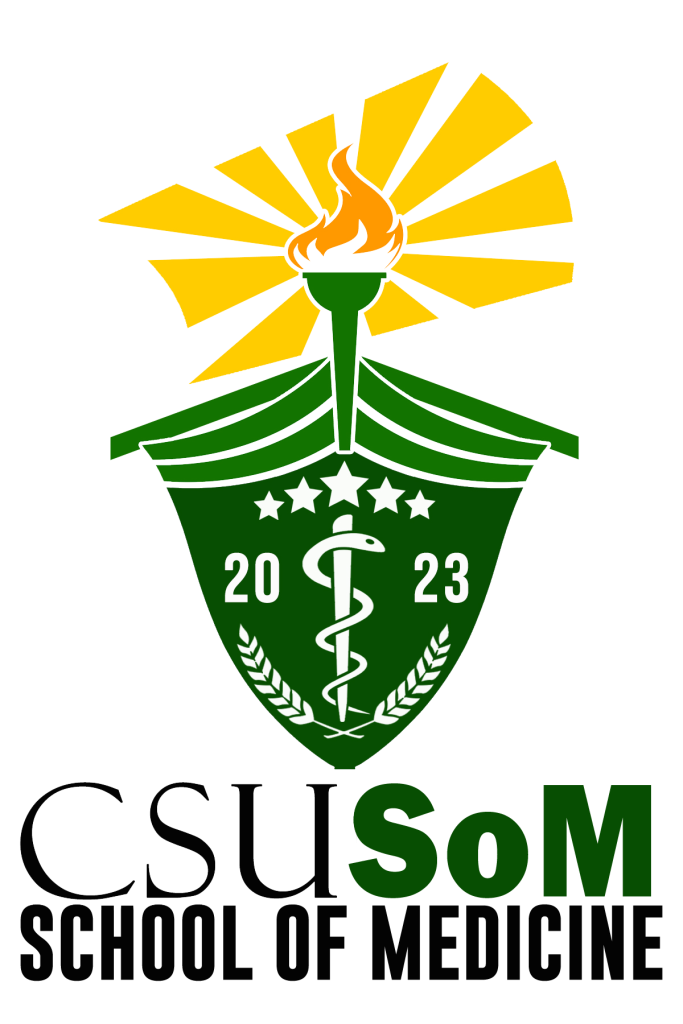- Home
- About
Official Seal

The Five (5) stars on the logo represent the graduate attributes of the Doctor of Medicine program namely; Healer, Health Educator, Social Mobilizer, Researcher, and Leader, molding them to become Five-Star Physicians geared towards the Doctor Para sa Bayan program of the Commission on Higher Education (CHED).
The Rod of Asclepius is a serpent-entwined rod wielded by the Greek god Asclepius, a deity associated with healing and medicine. This is the inspiration of the said symbol as the rod of Asclepius is considered the universal symbol for the practice of the medical healthcare profession.
The Laurel symbol below the rod holds a significant representation of qualities such as victory, honor, and accomplishment. For the CSU-SoM, the laurel symbolizes the school’s pursuit of knowledge, expertise, and excellence in affording medical services and care to the community.
The number 2023 marks the year of the inception of Caraga State University-School of Medicine as well as its approval of its offering.
The color green reflected throughout the seal of the CSU-SoM yielded its inspiration from the school color of the University which is green that symbolizes life, fertility, and productivity as per Section 2: Official Colors of the CSU Code (2019). Similarly, Health Mil. (2023) defined green as the color of nature, emitting a feeling of balance, harmony, and growth which also signifies health, serenity, and tranquility.
Vision
To be recognized as a medical school that sets innovative and excellent healthcare locally and globally.
Mission
CSU School of Medicine commits to produce competent, service-oriented, and ethical professionals towards the delivery of Universal Health Care for the Caraga Region and beyond.
Goal
The goal of the Doctor of Medicine Program is to develop the CSU-SoM Five-Star Doctor who is competent and confident to fulfill his/her role as a healer/health care provider, teacher/educator, researcher, leader/manager and social advocate.
Objectives
At the end of the program, the graduates should be able to:
- Practice as a five-star physician grounded on the foundation, philosophy, art, and science of competent medical practice.
- Develop into physicians who are culturally-sensitive, ethical, compassionate, and effective in the promotion of health through continuous professional development and lifelong learning.
- Demonstrate applied knowledge of biomedical, clinical, epidemiological, and psychosocial determinants of health.
- Perform inquiry, appraisal, and utilization of scientific evidence to improve patient care.
- Demonstrate leadership and social responsiveness within the healthcare system to effectively use existing resources and facilitate innovations.
Curriculum Framework
The Doctor of Medicine (M.D.) program at Caraga State University School of Medicine is characterized by a paradigm shift in medical education, reflecting a departure from traditional approaches.
- Innovative: The curriculum design at Caraga State University School of Medicine is forward-thinking and creative, incorporating novel teaching methods, technologies, or content that go beyond traditional approaches.
- Transformative: Alongside the principles of transformative education, the curriculum strives towards the realization of universal healthcare through primary health care. Teaching and learning are geared toward motivating and empowering learners to take informed decisions and actions at the individual, community, and global levels.
- Integrated: The curriculum have course threads that integrate various disciplines and targeted skills across all course blocks, promoting a holistic understanding of medicine. This could mean that basic sciences are intertwined with clinical experiences to provide a comprehensive education.
- Spiral: The curriculum is structured in a way that revisits and builds upon key concepts at different points in the program. It implies a continuous and iterative learning
- Organ System-Based: The curriculum educational approach organizes the teaching and learning of medical sciences around specific organ systems of the human body. This method is designed to integrate knowledge across various disciplines, such as anatomy, physiology, pathology, pharmacology, and clinical medicine, with a focus on the functional and structural aspects of specific organs and systems. process.


